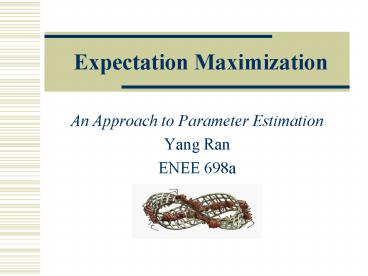Expectation Maximization - PowerPoint PPT Presentation
1 / 20
Title:
Expectation Maximization
Description:
... weights for every data point by running the responsibilities (weights) ... Maximize a loglikelihood function with the weights given by E step to update the ... – PowerPoint PPT presentation
Number of Views:29
Avg rating:3.0/5.0
Title: Expectation Maximization
1
Expectation Maximization
- An Approach to Parameter Estimation
- Yang Ran
- ENEE 698a
2
Outline
- Basic ideas of Expectation Maximization
- An example problem of Gaussian mixture
- General EM algorithm
- Further readings and conclusion
3
EM-Background
- How to classify points and estimate parameters of
the models in a mixture at the same time? - (Chicken and egg problem)
- In mixture of models, two targets are twisted
- The parameters of the models
- The assignment of each data point to the process
that generate it
4
Intuition in EM
- What is the INTUITION behind EM?
- Each of the step is easy assuming the other is
solved - Know the assignment of each data points, we can
estimate the parameters - Know the parameters of the distributions, we can
assign each point to a model ( eg. by MLE)
5
Key Factor in EM
- Adaptive hard clustering k-mean. Assign at each
point to only one class at each step. - Adaptive soft clustering EM. Data is assigned to
each class with a probability equal to the
relative likelihood of that point belonging to
the class.
6
Structure of EM Algorithm
- Initialization Pick start values for parameters
- Iteratively process until parameters converge
- Expectation (E) step Calculate weights for every
data point by running the responsibilities
(weights) - Maximization (M) step Maximize a loglikelihood
function with the weights given by E step to
update the parameters of the models
7
Example Gaussian Mixtures
- Problem N Samples Yi is from an population,
- where ? is 0 or 1 with P(? 1 ) p
- Question How to estimate the parameters
and the coefficients ( membership)
?using EM?
8
Example Gaussian Mixture
- The Log-likelihood based on N training samples
is - Directly maximization is numerically hard, but is
made easier with ?i known - Suppose ?i is known, the log-likelihood is
9
Sample Gaussian Mixture
10
Simulation
- The nonparametric density estimation of 1,000
simulated data generated by the distribution done
by Matlab
11
Simulation
- Results
12
Discuss for Gaussian Mixture
- How to construct initial values
- Simple way
- Think more
- Global maximizer is
not optimal - Looking for a good local maximizer s.t.
- In this sample
- Run EM with different initial values
- Choose the run giving highest likelihood
13
Discuss for Gaussian Mixture
- Results to show 3 mixtures of Gaussians
14
The EM in General
- Data Augmentation Maximization of the likelihood
is difficult, but is made easier by enlarging the
sample with latent (unobserved) data. - Latent (missing) data
- Previous sample the model memberships
- In general actual data that should have been
observed but missing
15
The EM in General-cntl
- Equation formulation
- 1.Bayesian gives
2.Taking conditional expectations w.r.t
16
The EM in General-cntl
- Why maximization in Q results in maximization in
- is the expectation of a log-likelihood
function, w.r.t the same density - By Jensens inequality, if maximizes Q
17
The EM in General-cntl
18
Conclusion
- Why? The problem of learning from incomplete data
where the labels of the data are missing is
considered. - How? An iterative procedure called EM based on
maximum likelihood and Bayes theorem is applied
to estimate the model and labels.
19
Conclusion
- Although EM method is powerful in many cases, but
we still have the following difficulties - EM is a method of MLE based on the complete data,
which assumes that the distribution family is
given. But in practice, this assumption is
usually inaccessible. - It is difficult to validate the optimal solution
of EM method. - Converge to local maxima.
20
References
- A. P. Dempster, N. M. Laird and D. B. Rubin,
"Maximum likelihood from incomplete data via the
EM algorithm", Journal of the Royal Statistical
Society Series B, vol. 39, no. 1, pp. 1--38, Nov.
1977 - T. Moon, "The Expectation-Maximization
algorithm", IEEE Signal Processing Magazine, pp.
47--60, Nov. 1996 - Yair Weiss, "Motion Segmentation using EM a short
tutorial, www.cs.huji.ac.il/yweiss/tutorials.htm
l































